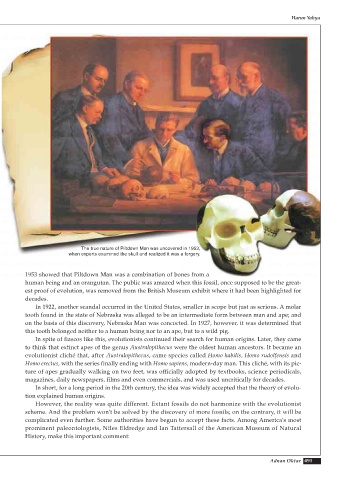Page 493 - Atlas of Creation Volume 3
P. 493
Harun Yahya
The true nature of Piltdown Man was uncovered in 1953,
when experts examined the skull and realized it was a forgery.
1953 showed that Piltdown Man was a combination of bones from a
human being and an orangutan. The public was amazed when this fossil, once supposed to be the great-
est proof of evolution, was removed from the British Museum exhibit where it had been highlighted for
decades.
In 1922, another scandal occurred in the United States, smaller in scope but just as serious. A molar
tooth found in the state of Nebraska was alleged to be an intermediate form between man and ape; and
on the basis of this discovery, Nebraska Man was concocted. In 1927, however, it was determined that
this tooth belonged neither to a human being nor to an ape, but to a wild pig.
In spite of fiascos like this, evolutionists continued their search for human origins. Later, they came
to think that extinct apes of the genus Australopithecus were the oldest human ancestors. It became an
evolutionist cliché that, after Australopithecus, came species called Homo habilis, Homo rudolfensis and
Homo erectus, with the series finally ending with Homo sapiens, modern-day man. This cliché, with its pic-
ture of apes gradually walking on two feet, was officially adopted by textbooks, science periodicals,
magazines, daily newspapers, films and even commercials, and was used uncritically for decades.
In short, for a long period in the 20th century, the idea was widely accepted that the theory of evolu-
tion explained human origins.
However, the reality was quite different. Extant fossils do not harmonize with the evolutionist
scheme. And the problem won't be solved by the discovery of more fossils; on the contrary, it will be
complicated even further. Some authorities have begun to accept these facts. Among America's most
prominent paleontologists, Niles Eldredge and Ian Tattersall of the American Museum of Natural
History, make this important comment:
Adnan Oktar 491

